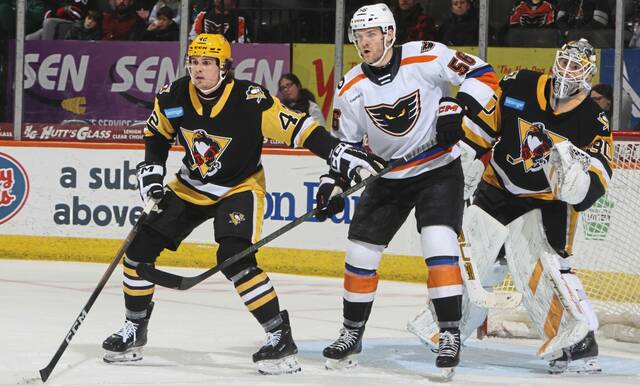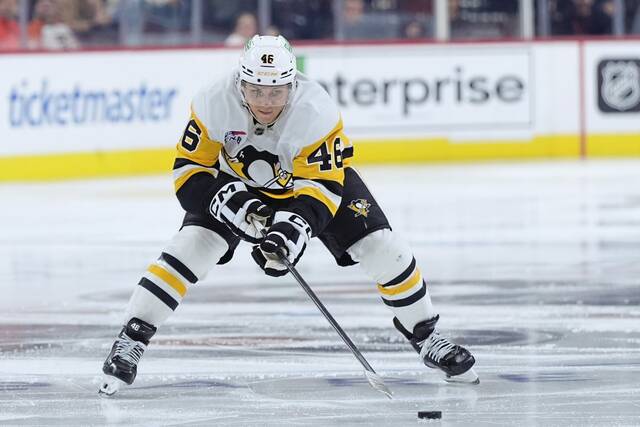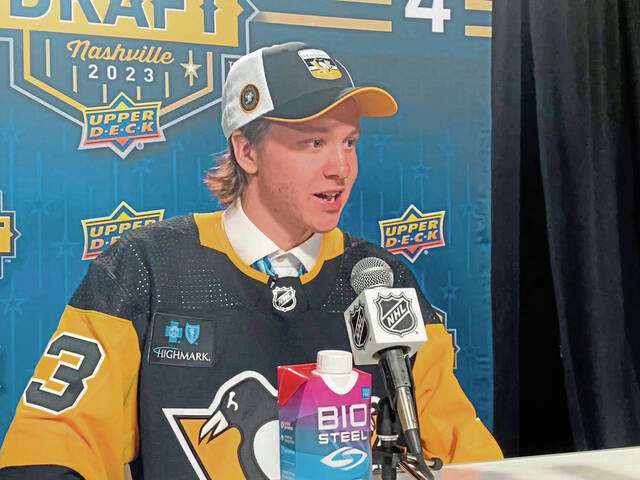The first question that springs to mind after the Pittsburgh Penguins traded winger Phil Kessel to the Arizona Coyotes on Saturday night is the easiest one to answer.
Friday, Dec. 6.
That’s when the Coyotes visit PPG Paints Arena this season, giving fans the chance to show their appreciation for the popular winger’s contributions to a pair of Stanley Cup championships.
Here are answers to eight other questions about the trade, which sent Kessel, a fourth-round draft pick and Dane Birks to Arizona for Alex Galchenyuk and Pierre-Olivier Joseph:
• When did the deal go down?
GM Jim Rutherford said he informed teams he was open for business immediately after the Penguins were swept out of the first round of the playoffs. He said talks intensified in the last five or six days.
• How does the deal make the Penguins better?
Looking at underlying numbers, Galchenyuk has been marginally better than Kessel defensively in their careers. When they’re on the ice at even strength, Galchenyuk’s teams have given up about three fewer shot attempts, three fewer shots on goal and 0.15 goals against per 60 minutes of ice time than Kessel’s teams. That’s not a big difference.
The Penguins are banking on Galchenyuk helping in other ways. Leaving the “change the culture” narrative aside for a moment, here’s one possibility: Coach Mike Sullivan was furious with Kessel’s casualness when he was on the ice for 13 shorthanded goals against last season and when the Penguins were outscored 5-0 when he was on the ice in overtime. Galchenyuk was on for four shorthanded goals and in overtime, the Coyotes outscored opponents 1-0 when he was on the ice.
• How does the deal make the Penguins worse?
The Penguins are taking a hit offensively, without a doubt. Using round numbers, Kessel has been a 30-goal scorer and Galchenyuk a 20-goal scorer in their careers.
• Where will Galchenyuk play?
Galchenyuk has played center and wing extensively, but reportedly prefers center. That isn’t likely to be his spot with the Penguins. Although it’s too early to tell, Evgeni Malkin’s left wing looks like a fine location for him.
• What does this do to the Penguins’ salary cap?
It saves them $1.9 million, which should help GM Jim Rutherford be more active when free agency opens on Monday. He won’t be able to spend freely, though. The Penguins have about $75 million committed to 10 forwards, seven defensemen and two goalies. Add in the projected salaries of restricted free agents Marcus Pettersson, Zach Aston-Reese and Teddy Blueger, and that leaves them about $2 million under the $81.5 million cap to potentially add one forward. A larger splash than that would require a trade to open more cap space.
• When Rutherford said earlier this month that he was willing to go into next season with Kessel on the roster, was he serious?
Well, he didn’t exactly back off that claim after the deal went down Saturday. In fact, he said Kessel and Sullivan could have continued to coexist if they had to. “I think it was a little bit blown out of proportion at times,” he said. “There were times that they didn’t agree on things, maybe as to what line he was on or whatnot, but that’s not an isolated case. That happens lots of times throughout our league. That was not the factor of him being moved. He certainly could have stayed here and they could have coexisted.”
• Who is Joseph?
An offensive defenseman picked by Arizona in the first round of the 2017 draft. He’s a big-time skater and puck mover, but at 6-foot-2, 168 pounds, he obviously has yet to physically mature. As such, Rutherford estimated his NHL arrival date as a few years from now. Regardless, he slots in near the top of the Penguins’ top 10 prospects list, right in the same neighborhood as defenseman Calen Addison.
• Who is Birks?
A stay-at-home defenseman picked by the Penguins in the sixth round of the 2013 draft. He spent almost all of last season with the ECHL’s Wheeling Nailers, recording one goal and 14 points. He was either included in the deal because the Coyotes have taken a special interest in him or, more likely, to even out the number of NHL contracts involved in the deal. NHL teams are allowed to have 50 players under contract. The Penguins have 41.








